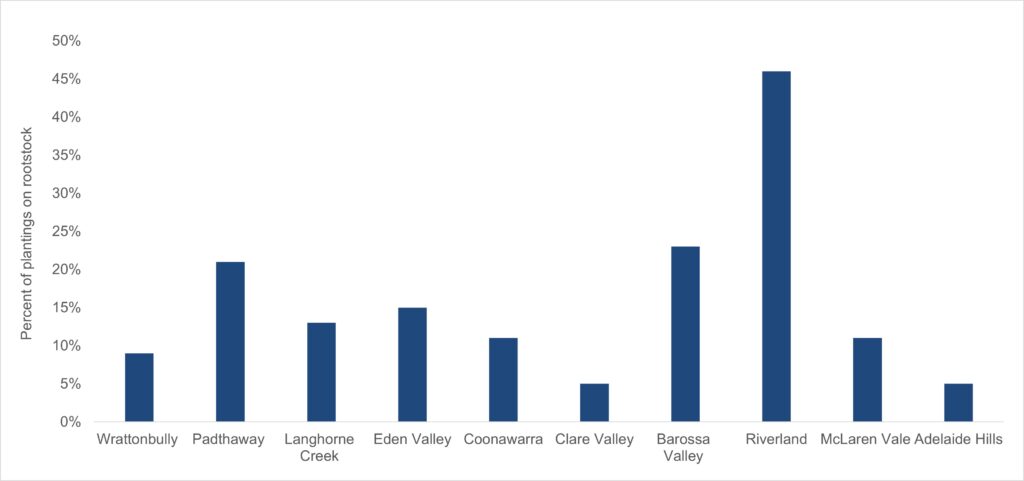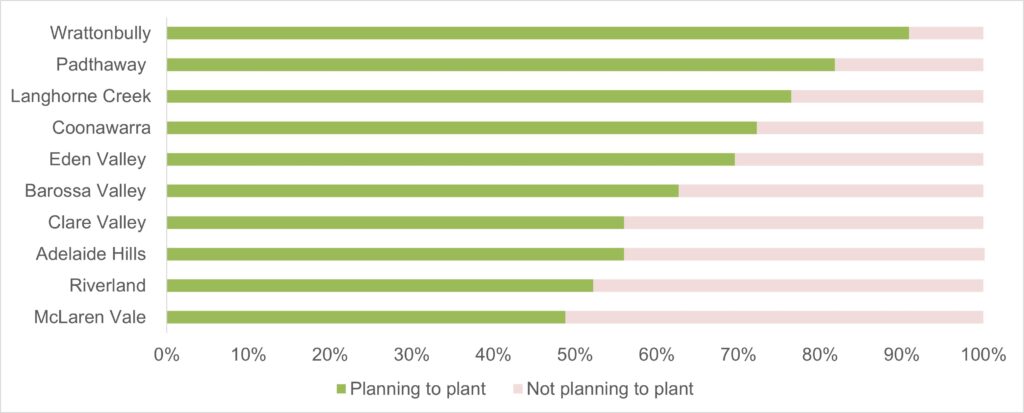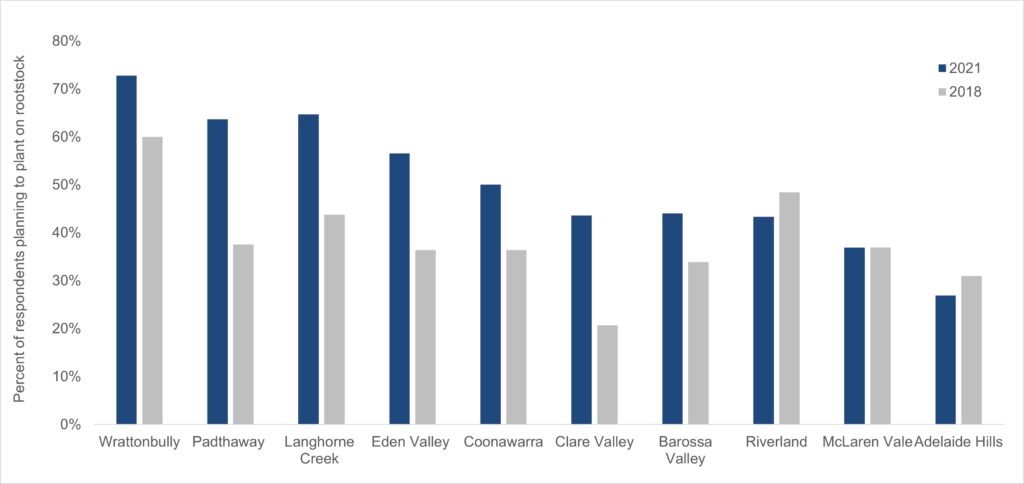Vineyards can be planted using either grafted vines or own-rooted vines. Planting a grape variety grafted onto a selected rootstock can provide vineyard owners with a range of benefits, one of which includes counteracting biosecurity risk.
To gauge the level of intent to use rootstocks for new vineyard plantings over the next five years, Vinehealth Australia surveyed vineyard owners in our 2021 Vineyard Owner Survey. The intent to use rootstocks reported in this 2021 survey was compared with that reported in the 2018 survey.
Results from the 2021 survey indicated that one in two vineyard owners who responded are planning to plant vines in next five years, and there is an increased intention to use rootstocks for all or part of these plantings as compared to in 2018.
From the 393 respondents to this question in the 2021 survey, 51% said they were planning to plant vines in the next five years. Of these, 71% said they would be likely to use rootstocks for all of some of the area.
From the 311 respondents to this question in the 2018 survey, 58% of respondents said they were planning to plant vines in the next five years, and 59% of these said they were likely to use rootstocks for some or part of the plantings.
The current proportion of vineyards in South Australia planted to rootstock by region is shown in Figure 1, with the Riverland having the highest level at 46% and the Clare Valley and Adelaide Hills having the lowest level at 5%.

Figure 1. Regional comparison of current vineyard plantings on rootstock (data extracted from Vinehealth Australia’s Register on 25 November 2021)
A regional analysis of the intention to plant a new vineyard, and whether rootstocks would be used, was completed for both the 2021 and 2018 surveys.
Regional analysis of new vineyard plantings
Figure 2 shows that survey respondents from Wrattonbully, Padthaway, Langhorne Creek and Coonawarra reported the highest intent to plant a new vineyard in the next five years. This is consistent with planting trends in the Limestone Coast reported in recent SA Winegrape Crush Surveys, with the largest plantings by area in South Australia in the 2021 report in Padthaway, and in the 2020 report in Coonawarra.

Figure 2. Vineyard Owner Survey 2021: Percentage split of respondents planning to plant vineyards in the next five years by region. Only regions with greater than 10 respondents are presented.
Discussions with the South Australian propagation sector verified the strong planting trends, particularly in the Limestone Coast, and that these trends are being led by larger growers.
Comparing results from the 2021 and 2018 surveys, regional differences were noted in the proportion of respondents indicating their intent to plant new vineyards in the coming five years:
- Eden Valley, Barossa Valley and Adelaide Hills regions each showed similar levels of intention to plant new vineyards in 2018 and 2021.
- Respondents in Wrattonbully, Padthaway and Coonawarra showed the greatest increase in intent to plant new vineyards in the 2021 survey as compared to the 2018 survey, being 31%, 18% and 17%, respectively.
- Respondents in McLaren Vale indicated a 13% reduction in intent to plant new vineyards in the 2021 survey as compared to the 2018 survey.
Discussions of these results with the propagation sector verified the increased demand from the Limestone Coast for planting material. However, the lower intent for planting material from McLaren Vale was not reflective of what they had experienced – perhaps impacted by the situations of the respondents who took part in the surveys from this region.
Regional analysis of intent to use rootstocks for new plantings
For those planning to plant new vineyards in the coming five years, Figure 3 shows regional differences in the intent to use rootstocks for some or all of these plantings. In the 2021 survey, wine regions in the Limestone Coast, Langhorne Creek and Eden Valley showed greater than 50% of respondents intending to use rootstocks for some or all of their new plantings. The lowest intent to use rootstocks was noted for the Adelaide Hills at 27%.
The driving factors for choosing to plant with rootstocks are likely to be regionally-specific.
In the Limestone Coast, this high intention to use rootstocks for new plantings may be in response to relative proximity to Victorian Phylloxera Infested Zones, as well as general futureproofing and diversification for climate change.
Discussions with the South Australian propagation sector highlighted that for Clare in particular, the higher intent to use rootstocks in 2021 as compared to 2018, is reflective of a desire to purchase drought-tolerant rootstocks to combat the lack of available water in the region.
There was an increased intent to use rootstocks for all regions in 2021 as compared to that reported in the 2018 survey, except the Riverland, McLaren Vale and Adelaide Hills.

Figure 3. Vineyard Owner Surveys 2021 and 2018: Level of intention by respondents in each region to use grafted vines for new vineyard plantings in the next five years. Regions with greater than 10 respondents in 2021 are presented for both years. Note that number of respondents in Wrattonbully and Padthaway was less than 10 in the 2018 Survey.
High intention to use rootstocks
The high level of intent to incorporate rootstocks in new plantings is pleasing from a biosecurity perspective as a risk management tool, indicating that vineyard owners are adapting their management to safeguard the long-term sustainability of their vineyard assets.
The increased intent of vineyard owners to use rootstocks may be indicative of:
- Demonstrated grape and wine quality from vines planted on rootstock in Australia.
- Wineries/winemakers showing more encouragement towards their contracted growers to plant on rootstock; particularly in wine regions where rootstock plantings have traditionally been low.
- Businesses viewing rootstocks as an asset and a long-term risk management tool.
- Businesses learning how to better manage rootstock vines both through trial and error and learning from their peers.
- Businesses making more informed choices about matching rootstock to soil type and climatic conditions. This may be helped by:
- growers being more proactive in discussing these choices with nurseries/vine improvement associations;
- having ready access to tools such as Wine Australia’s Grapevine rootstock selector tool, and other such tools and information available through individual nursery/vine improvement websites from in Australia and internationally; and
- greater availability to side-by-side plantings of different rootstocks to evaluate their characteristics.
- Scientific literature published on the merits of different rootstocks.
The realisation of this high intent by winegrape growers to use rootstocks for new plantings, will however depend on supply of material.
Discussions with those in the South Australian propagation sector confirmed current strong demand for rootstocks, but that much of this over the past five years has been driven by the table grape industry, with a preference for 1103 Paulsen.
Demand for rootstocks has outstripped supply in recent years, especially with some rootstock blocks affected by adverse weather events, thus decreasing the volume of suitable wood available for cutting.
From a broader perspective, the strategic management of rootstock blocks is key to meeting changing demand over time. We have seen that during times of low demand for rootstocks, rootstock capacity was subsequently reduced, therefore we are now seeing a time lag to ramp up production to meet the current upswing in demand.
In the 2021 survey, pest resistance was a key reason given for intending to plant on rootstocks. Other reasons included managing the effects of climate change, drought tolerance, salt tolerance, water use efficiency and consistency of yield and fruit set.
Barriers to rootstock use identified in the 2021 survey include a preference for wine quality from own roots, cost of rootstocks, lack of pest issues, difficulty in sourcing required clone/rootstock and lack of information on appropriate scion/rootstock.
Discussions with the South Australian propagation sector confirmed that more common reasoning provided by their clients for desiring rootstocks was consistency of and increased yield, drought tolerance, higher colour, nematode issues, salt and reduced vigour in cool climates.
Those clients requesting own-rooted material most commonly stated that cost was the prohibitive factor in choosing rootstocks. It is noted that there is potentially a lack of understanding by industry of the steps involved in the production of a grafted vine and associated costs with these steps.